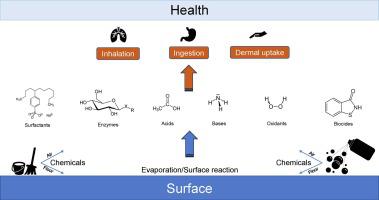当前位置:
X-MOL 学术
›
Environ. Int.
›
论文详情
Our official English website, www.x-mol.net, welcomes your feedback! (Note: you will need to create a separate account there.)
Cleaning products: Their chemistry, effects on indoor air quality, and implications for human health
Environment International ( IF 10.3 ) Pub Date : 2024-06-18 , DOI: 10.1016/j.envint.2024.108836 Heidi Salonen , Tunga Salthammer , Emmanuelle Castagnoli , Martin Täubel , Lidia Morawska
Environment International ( IF 10.3 ) Pub Date : 2024-06-18 , DOI: 10.1016/j.envint.2024.108836 Heidi Salonen , Tunga Salthammer , Emmanuelle Castagnoli , Martin Täubel , Lidia Morawska

|
The use of cleaning and disinfecting products both at work and at home increased during the COVID-19 pandemic. Those products often include surfactants, acids/bases, carcinogens such as chloroform, and endocrine-disrupting chemicals, such as cyclosiloxanes, phthalates, and synthetic fragrances, which may cause harmful health effects among professional cleaners as well as among people exposed at home or in their workplaces. The aim of this study was to synthesize the effects of the commonly used chemical, surface cleaning and disinfecting products on indoor air quality, focusing on chemical and particulate matter pollutants, exposure, and human health in residential and public buildings. We also provide a summary of recommendations to avoid harmful exposure and suggest future research directions. PubMed, Google Scholar, Scopus, and Web of Science (WoS) were used to search the literature. Analysis of the literature revealed that the use of cleaning products and disinfectants increase occupants’ exposure to a variety of harmful chemical air contaminants and to particulate matter. Occupational exposure to cleaning and disinfectant products has been linked to an increased risk of asthma and rhinitis. Residential exposure to cleaning products has been shown to have an adverse effect on respiratory health, particularly on asthma onset, and on the occurrence of asthma(-like) symptoms among children and adults. Efforts to reduce occupants’ exposure to cleaning chemicals will require lowering the content of hazardous substances in cleaning products and improving ventilation during and after cleaning. Experimentally examined, best cleaning practices as well as careful selection of cleaning products can minimize the burden of harmful air pollutant exposure indoors. In addition, indirect ways to reduce exposure include increasing people’s awareness of the harmfulness of cleaning chemicals and of safe cleaning practices, as well as clear labelling of cleaning and disinfecting products.
中文翻译:

清洁产品:其化学成分、对室内空气质量的影响以及对人类健康的影响
在 COVID-19 大流行期间,工作场所和家庭中清洁和消毒产品的使用有所增加。这些产品通常包括表面活性剂、酸/碱、氯仿等致癌物质以及环硅氧烷、邻苯二甲酸盐和合成香料等内分泌干扰化学物质,这些物质可能对专业清洁工以及在家或在室外接触的人造成有害的健康影响。他们的工作场所。本研究的目的是综合常用化学品、表面清洁和消毒产品对室内空气质量的影响,重点关注住宅和公共建筑中的化学和颗粒物污染物、暴露和人体健康。我们还提供了避免有害接触的建议摘要,并提出了未来的研究方向。使用 PubMed、Google Scholar、Scopus 和 Web of Science (WoS) 来检索文献。文献分析表明,清洁产品和消毒剂的使用会增加居住者接触各种有害化学空气污染物和颗粒物的机会。职业接触清洁和消毒产品与哮喘和鼻炎的风险增加有关。事实证明,在住宅中接触清洁产品会对呼吸系统健康产生不利影响,特别是对哮喘发作以及儿童和成人哮喘(类似)症状的发生。为了减少住户接触清洁化学品的机会,需要降低清洁产品中有害物质的含量,并改善清洁期间和清洁后的通风。经过实验检验,最佳清洁实践以及仔细选择清洁产品可以最大程度地减少室内有害空气污染物暴露的负担。 此外,减少接触的间接方法包括提高人们对清洁化学品的危害性和安全清洁实践的认识,以及清洁和消毒产品的清晰标签。
更新日期:2024-06-18
中文翻译:

清洁产品:其化学成分、对室内空气质量的影响以及对人类健康的影响
在 COVID-19 大流行期间,工作场所和家庭中清洁和消毒产品的使用有所增加。这些产品通常包括表面活性剂、酸/碱、氯仿等致癌物质以及环硅氧烷、邻苯二甲酸盐和合成香料等内分泌干扰化学物质,这些物质可能对专业清洁工以及在家或在室外接触的人造成有害的健康影响。他们的工作场所。本研究的目的是综合常用化学品、表面清洁和消毒产品对室内空气质量的影响,重点关注住宅和公共建筑中的化学和颗粒物污染物、暴露和人体健康。我们还提供了避免有害接触的建议摘要,并提出了未来的研究方向。使用 PubMed、Google Scholar、Scopus 和 Web of Science (WoS) 来检索文献。文献分析表明,清洁产品和消毒剂的使用会增加居住者接触各种有害化学空气污染物和颗粒物的机会。职业接触清洁和消毒产品与哮喘和鼻炎的风险增加有关。事实证明,在住宅中接触清洁产品会对呼吸系统健康产生不利影响,特别是对哮喘发作以及儿童和成人哮喘(类似)症状的发生。为了减少住户接触清洁化学品的机会,需要降低清洁产品中有害物质的含量,并改善清洁期间和清洁后的通风。经过实验检验,最佳清洁实践以及仔细选择清洁产品可以最大程度地减少室内有害空气污染物暴露的负担。 此外,减少接触的间接方法包括提高人们对清洁化学品的危害性和安全清洁实践的认识,以及清洁和消毒产品的清晰标签。











































 京公网安备 11010802027423号
京公网安备 11010802027423号